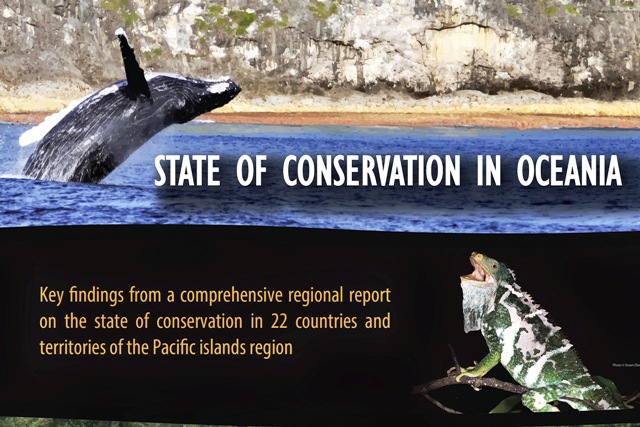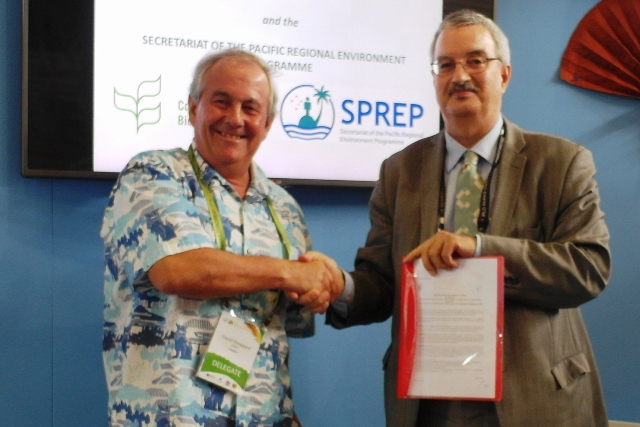A report outlining the state of conservation in Oceania was launched and discussed during Saturday's "Pacific Islands Dialogue" at the World Parks Congress in Sydney on Saturday 15 November.
The State of Conservation in Oceania Report (SOCO), commissioned by the Secretariat of the Pacific Regional Environment Programme (SPREP), was launched at the start of the Pacific Islands Dialogue. SPREP's head of Biodiversity and Ecosystems, Stuart Chape, presented a synopsis of the report, which highlights the realities of the state of the natural environment in 22 Pacific island countries and territories. The assessment was undertaken at national, territorial and regional level.
The synthesis of regional level findings presents an overall picture of concern for the status of Pacific ecosystems and species.
"While the current status, pressures and threats for almost all of the indicators was assessed as fair, the major concern is that the trends are deteriorating for most indicator ecosystems and species," said Mr Chape.
As an example, 7.3% of the region's forests was lost between 1990 and 2010 and, of the almost 6,000 known species in the region, 1,774 are listed on the IUCN Red List ranging from Near Threatened to Critically Endangered, with 117 already extinct in the wild. The assessment has also identified that more work needs to be done to determine the status of 824 species which are classified as 'data deficient'.

"Fortunately, in terms of governance and the response to conservation issues, the trend is improving," said Mr Chape. At the same time, he noted that the SOCO has also identified that current implementation of legislation and key policy instruments such as National Biodiversity Strategies and Action Plans is poor.
Importantly, protected area coverage is also currently poor, especially in terrestrial ecosystems. An analysis of the distribution of the 2,777 mammals, birds, amphibians, marine bony fishes, cartilaginous fishes, corals, decapods, mangroves and seagrasses for which spatial data is available, indicates limited inclusion in protected areas.
The report is clear that more needs to be done to establish better conservation and management areas and systems for the region's valuable species, and this includes species that are utilised by people for livelihoods, food security and other ecosystem services.
The data that has been collected for the assessment will be used to help guide conservation and environmental management action at national and regional levels, and will establish a baseline for ongoing periodic analysis. As an ongoing process it will play a key role in guiding national policy and community level action to help achieve the Aichi Targets.
The State of Conservation in Oceania Report (SOCO), commissioned by the Secretariat of the Pacific Regional Environment Programme (SPREP), was launched at the start of the Pacific Islands Dialogue. SPREP's head of Biodiversity and Ecosystems, Stuart Chape, presented a synopsis of the report, which highlights the realities of the state of the natural environment in 22 Pacific island countries and territories. The assessment was undertaken at national, territorial and regional level.
The synthesis of regional level findings presents an overall picture of concern for the status of Pacific ecosystems and species.
"While the current status, pressures and threats for almost all of the indicators was assessed as fair, the major concern is that the trends are deteriorating for most indicator ecosystems and species," said Mr Chape.
As an example, 7.3% of the region's forests was lost between 1990 and 2010 and, of the almost 6,000 known species in the region, 1,774 are listed on the IUCN Red List ranging from Near Threatened to Critically Endangered, with 117 already extinct in the wild. The assessment has also identified that more work needs to be done to determine the status of 824 species which are classified as 'data deficient'.

"Fortunately, in terms of governance and the response to conservation issues, the trend is improving," said Mr Chape. At the same time, he noted that the SOCO has also identified that current implementation of legislation and key policy instruments such as National Biodiversity Strategies and Action Plans is poor.
Importantly, protected area coverage is also currently poor, especially in terrestrial ecosystems. An analysis of the distribution of the 2,777 mammals, birds, amphibians, marine bony fishes, cartilaginous fishes, corals, decapods, mangroves and seagrasses for which spatial data is available, indicates limited inclusion in protected areas.
The report is clear that more needs to be done to establish better conservation and management areas and systems for the region's valuable species, and this includes species that are utilised by people for livelihoods, food security and other ecosystem services.
The data that has been collected for the assessment will be used to help guide conservation and environmental management action at national and regional levels, and will establish a baseline for ongoing periodic analysis. As an ongoing process it will play a key role in guiding national policy and community level action to help achieve the Aichi Targets.
 L - R Mr David Sheppard, SPREP and Dr. Braulio Ferreira de Souza Dias, CBD.
L - R Mr David Sheppard, SPREP and Dr. Braulio Ferreira de Souza Dias, CBD.



.jpg)













